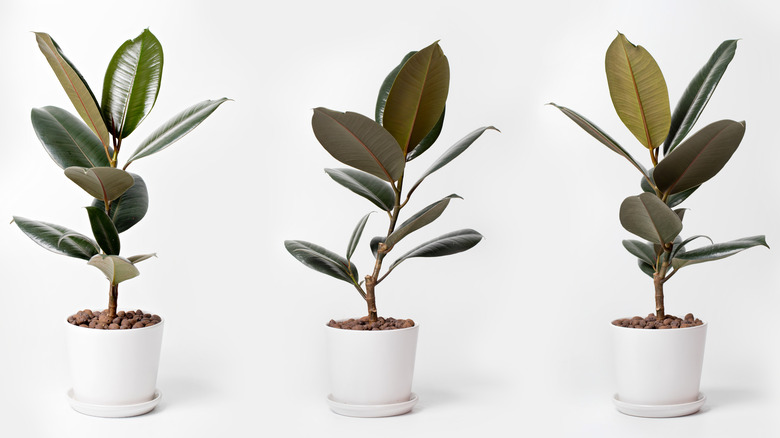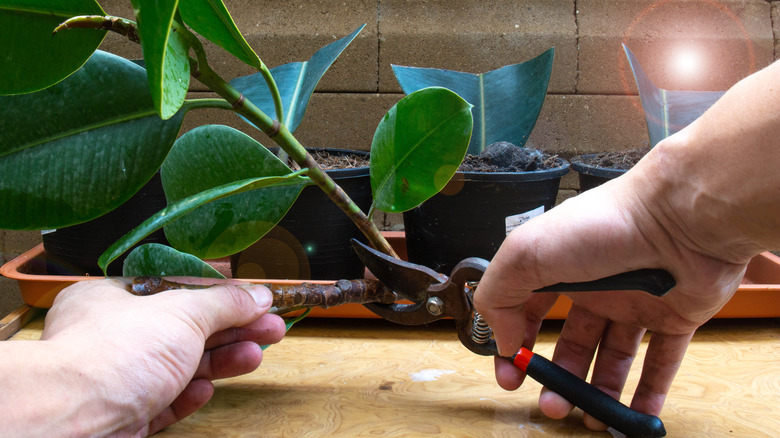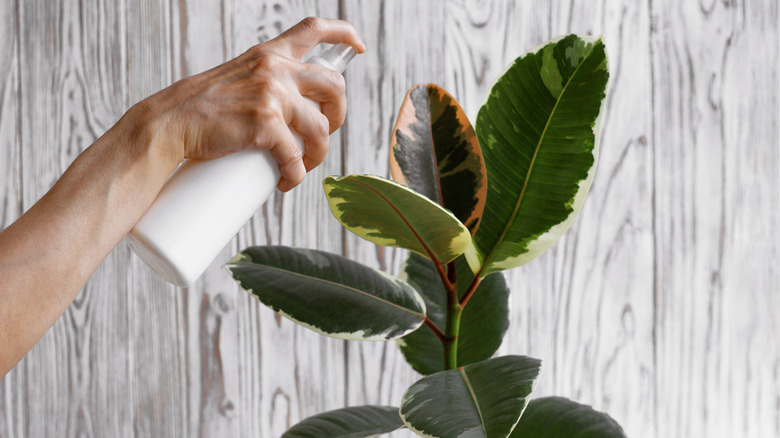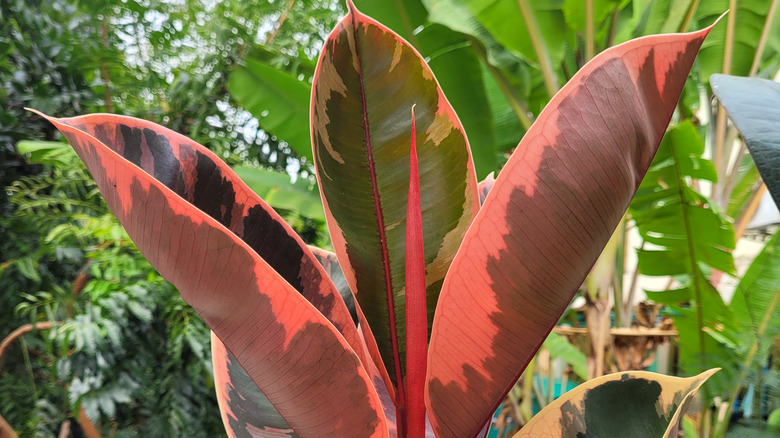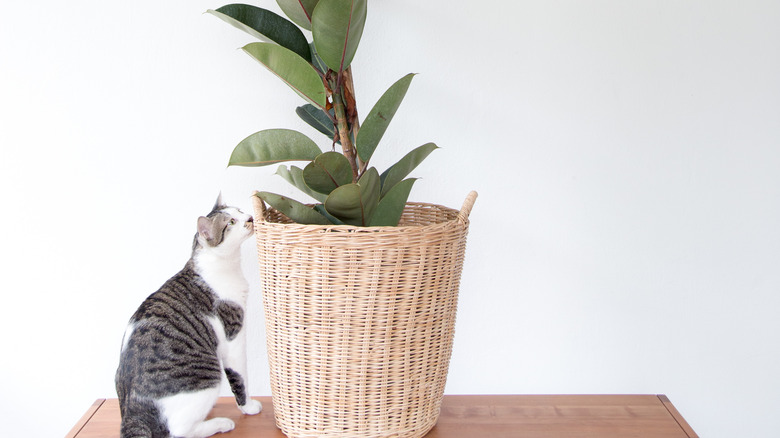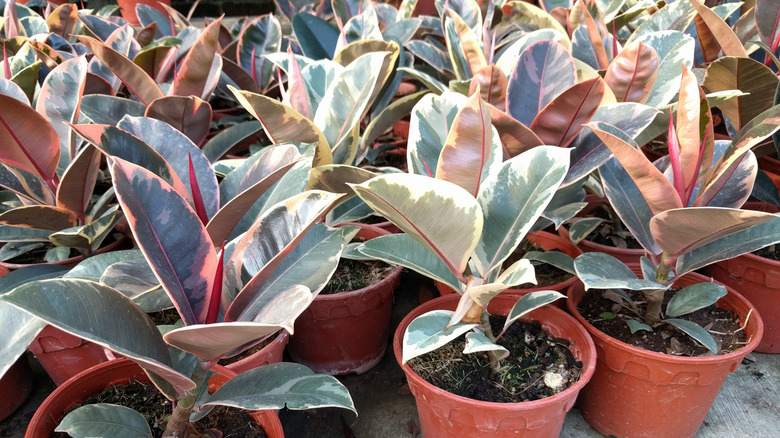How To Successfully Grow A Rubber Tree Houseplant
The rubber tree houseplant, Ficus elastica, is an evergreen tropical plant from Southeast Asia. With a thick trunk and waxy green leaves that often have reddish undertones, this incredibly popular houseplant is a member of the fig tree family. Rubber trees have been known to grow upwards of 200 feet tall in the wild; however, they can be easily maintained as a medium-size shelf plant when kept indoors. In a home with high ceilings and tons of light, though, a rubber tree can grow to as much as 10 feet tall, making it a great option as a floor plant.
The latex in these plants was once used to make rubber, hence its apropos nickname. However, as per Treehugger, the common rubber tree plant found in garden centers should not be confused with the Pará rubber tree (Hevea brasiliensis), from which almost all latex for commercial rubber is harvested. While rubber trees can only grow outdoors in tropical regions, they are generally easy to care for when kept indoors, where they can be shaped into bushy shrubs or slender single-trunk trees.
How to grow a rubber tree
Rubber tree houseplants require high volumes of indirect light to grow and stay healthy. Therefore, find the sunniest area when looking for the best spot in your home to grow this tree. Still, if that spot is right in front of a window, you may need to consider a sheer curtain for certain times of the day because harsh direct sunlight has the potential to burn this plant's leaves. In addition, low light is more likely to cause leaves to fade in color and fall off. For this reason, Bob Vila suggests choosing a young tree to start with, which will allow it sufficient time to acclimate to its indoor conditions from its earliest stages. Older plants that have been kept outdoors for a long time will also have a harder time getting used to a lower light environment.
You can easily propagate a rubber plant with stem cuttings, and you'll have the best results doing so in spring or summer. First, cut a 6-inch piece of the stem (or longer) with a minimum of four-leaf nodes. Let the sap dry for a few days. Next, snip off just the bottom few leaves, then dip the cut side into rooting powder before planting it in a well-draining potting soil mix. Remember, these are tropical flora, so it's important to keep your baby plant toasty warm by placing its container on a heating mat.
How to care for a rubber tree
Rubber trees are generally easy to care for. However, keep in mind that they like to stay warm year-round and should not be left anywhere below 60-degrees Fahrenheit. Rubber trees are accustomed to high humidity but will fare just fine at a more average level. If you live in a particularly dry setting, regular misting or adding a humidifier to your room can help them look and feel their best. In terms of watering, ensure that the top few inches of soil are dry before giving the plant a drink. A good soak with warm water every one to two weeks should suffice. When watering, allow excess water to drain, then be sure to empty the overfill tray, so your plant doesn't get stuck in moisture.
SFGate recommends a monthly 10:10:10 fertilizer mixture containing nitrogen, phosphorous, and potassium during spring and summer. Rubber trees do not need to be fertilized during the cooler fall and winter months. One more hot tip from SFGate for maintaining a happy rubber tree is to rotate its position every few weeks. This will help it grow evenly on all sides.
Rubber tree varieties
Ficus elastica has several common varieties, including robusta, decora, tricolor, tineke, doescheri, and burgundy. According to Balcony Garden Web, they look amazing as houseplants with their waxy leaves and are excellent anti-pollutant plants. Consider these Ficus elastica varieties if you're looking for a plant that can add some brightness to your room.
- Ficus elastica 'Tricolor' is very popular among houseplant enthusiasts. The leaves of this variety are a combination of green, pink, and creamy white.
- Ficus elastica 'Tineke' has green and cream tones in its leaves, but the stems show pink. Garden For Indoor explains that this variety will lose its multicolored pattern and become greener when kept in insufficient light. Moreover, the pink hue of the Tineke leaf veins is only noticeable in new growth and fades away.
- Ficus elastica 'Doescheri' is a broadleaf variety with variegated leaves in green and white. The color patterns of these plants are sometimes mottled, making each leaf look like an individual painting.
- Ficus elastica 'Burgundy' has new growth that appears deep crimson at first. However, once this reddish tint fades, the leaves will transform into a green so dark it can even look black in low lighting.
Is the rubber tree toxic?
The ASPCA confirms that the common rubber tree is not toxic to dogs, cats, or horses and is safe to keep in the home. This holds true for humans as well. Although, as with all houseplants, poisonous or not, you should still be careful. Do not keep a rubber tree on the floor if you have a pet who is particularly prone to munching on leaves. Even though it is not deathly toxic, over-ingestion of any plant, including this one, can lead to an upset stomach and mild vomiting.
Do you have a latex allergy? If so, take extra precaution when handling a rubber tree because its leaves do contain natural latex, which can cause irritation for a person with a latex allergy. In addition, milky white sap will drip from a plant that has been accidentally broken or intentionally pruned, so wear gloves when working with this plant and quickly wash exposed skin with soap and warm water.
How to repot a rubber tree
These plants can handle becoming rootbound to a certain degree, so restricting yours to a small pot is one way to keep it moderate in size. However, it's important not to let those roots get too wound up because the trees grow so fast. Growth in overall height will demand expansion in width at the root ball in order to ensure proper support. Eventually, any rootbound plant needs to be transplanted into a larger pot to give its establishment room to spread out and remain healthy. Don't forget; you can always safely trim roots when repotting.
An added benefit of repotting your rubber tree is that fresh new soil means fresh nutrients. The Healthy Houseplant explains that it's challenging to keep a rootbound rubber tree properly watered. Soil that is too wet or too dry can severely stress out even the hardiest plants. It also becomes a breeding ground for disease and root rot. When you're ready to encourage new growth on your rubber tree, choose a new pot that is 1/3 larger than the original. Ensure it has drainage holes and fill its bottom with a well-draining indoor potting mix. Brace the base of your rubber tree before slipping it out of the smaller pot and gently move it to its new larger home. Backfill the remaining space in the new pot, water, and voilà! Your rubber tree houseplant is ready to grow again.
From little plant to mighty commercial product
As far back as the 16th century, Mesoamerican people processed natural rubber from the latex sap of the trees native to their region. However, it wasn't until the 1830s that it became known in the United States. Initially, raw rubber was praised for its waterproof quality and because it could be formed into any shape. The only problem was its susceptibility to extreme temperatures, melting in summer or freezing during winter. Charles Goodyear, an American inventor and chemist, solved this problem by inventing the process that led to commercially viable rubber; and he did so by accident. According to Interesting Engineering, while he was serving jail time for issues with a creditor, Goodyear wiled away the hours experimenting with raw rubber samples. After his release from prison and many years of failed experiments, he happened upon the process of vulcanization when he unintentionally dropped sulfur with rubber on a hot stovetop.
The ensuing vulcanization hardened the rubber, forcing it to maintain its shape no matter what temperature it was exposed to. This process catapulted the otherwise unknown tropical plant to international fame. Sadly, Goodyear had tremendous difficulty obtaining the patents for his inventions. He died in 1860 with little acclaim and massive financial debt. Luckily for his family, future royalties and Charles' son's ingenuity for machinery got them back on their feet. Nearly 40 years after his death, the Goodyear tire company says its brand name came in honor of him.
